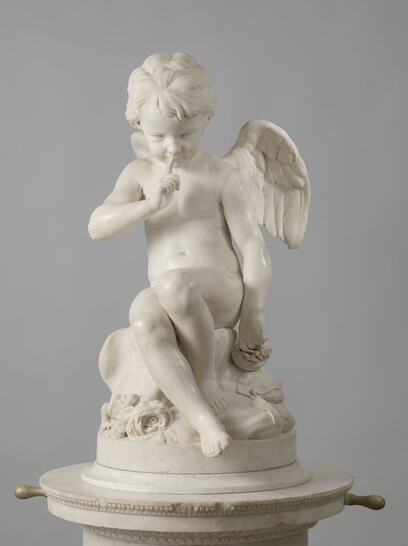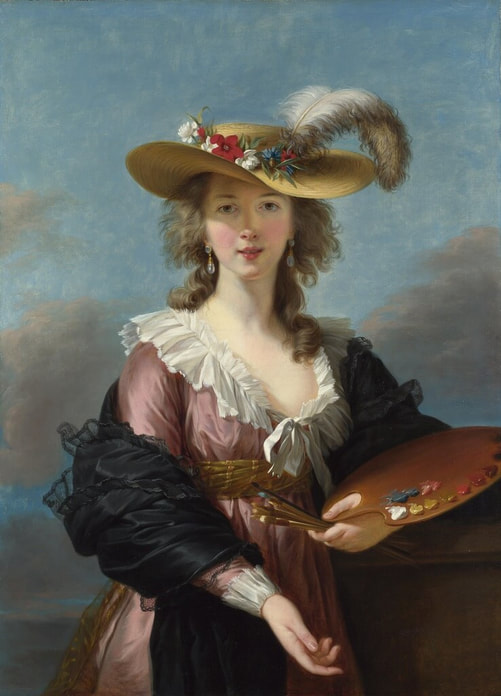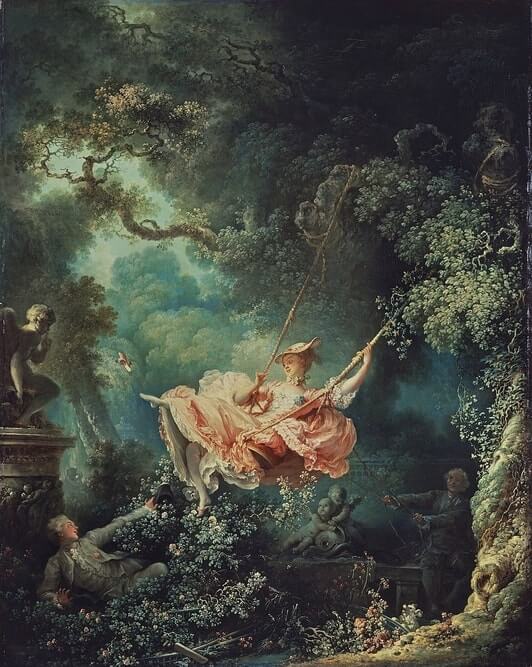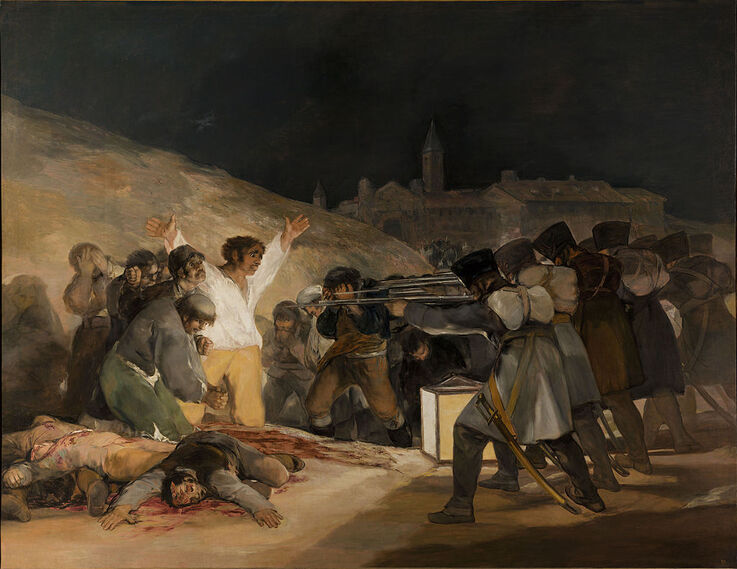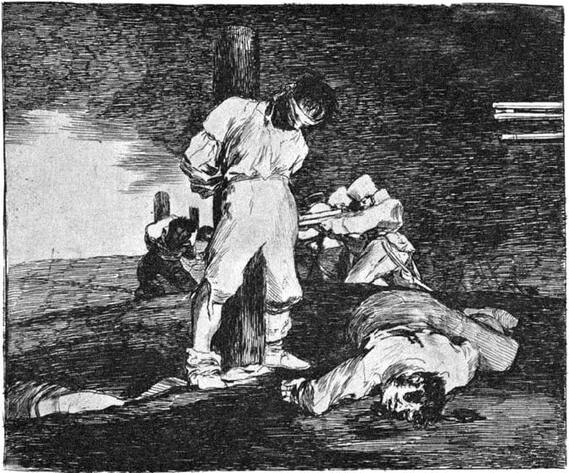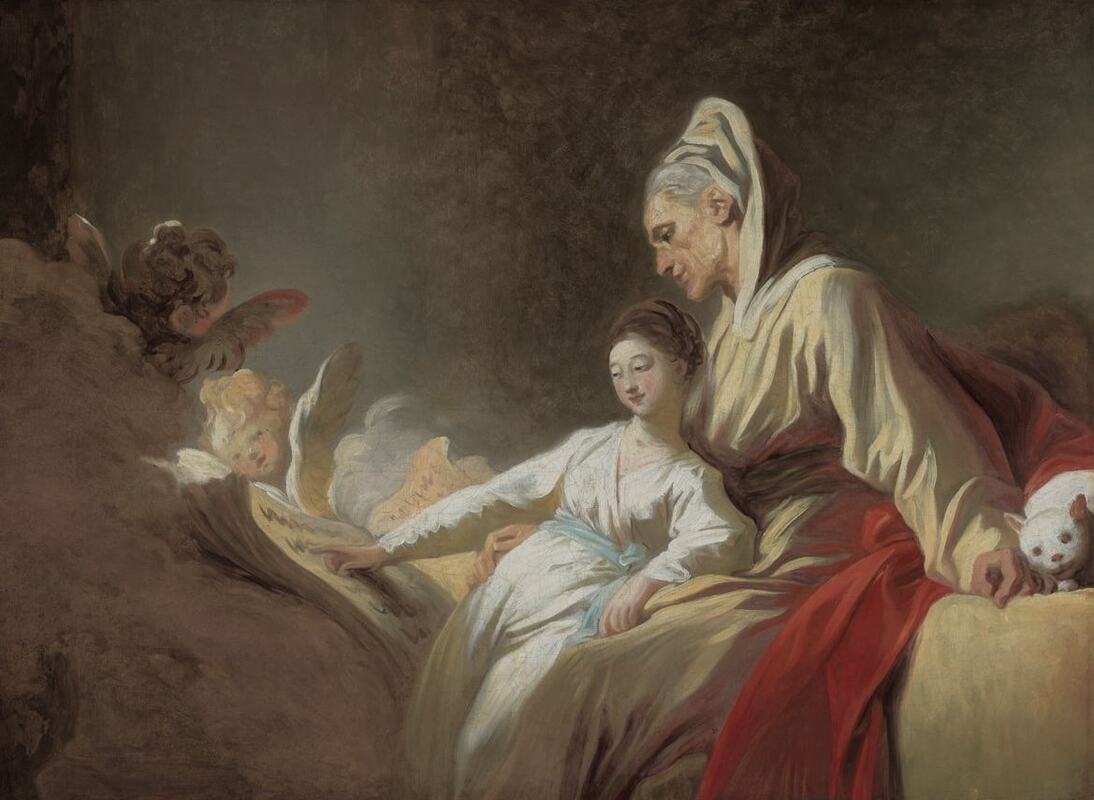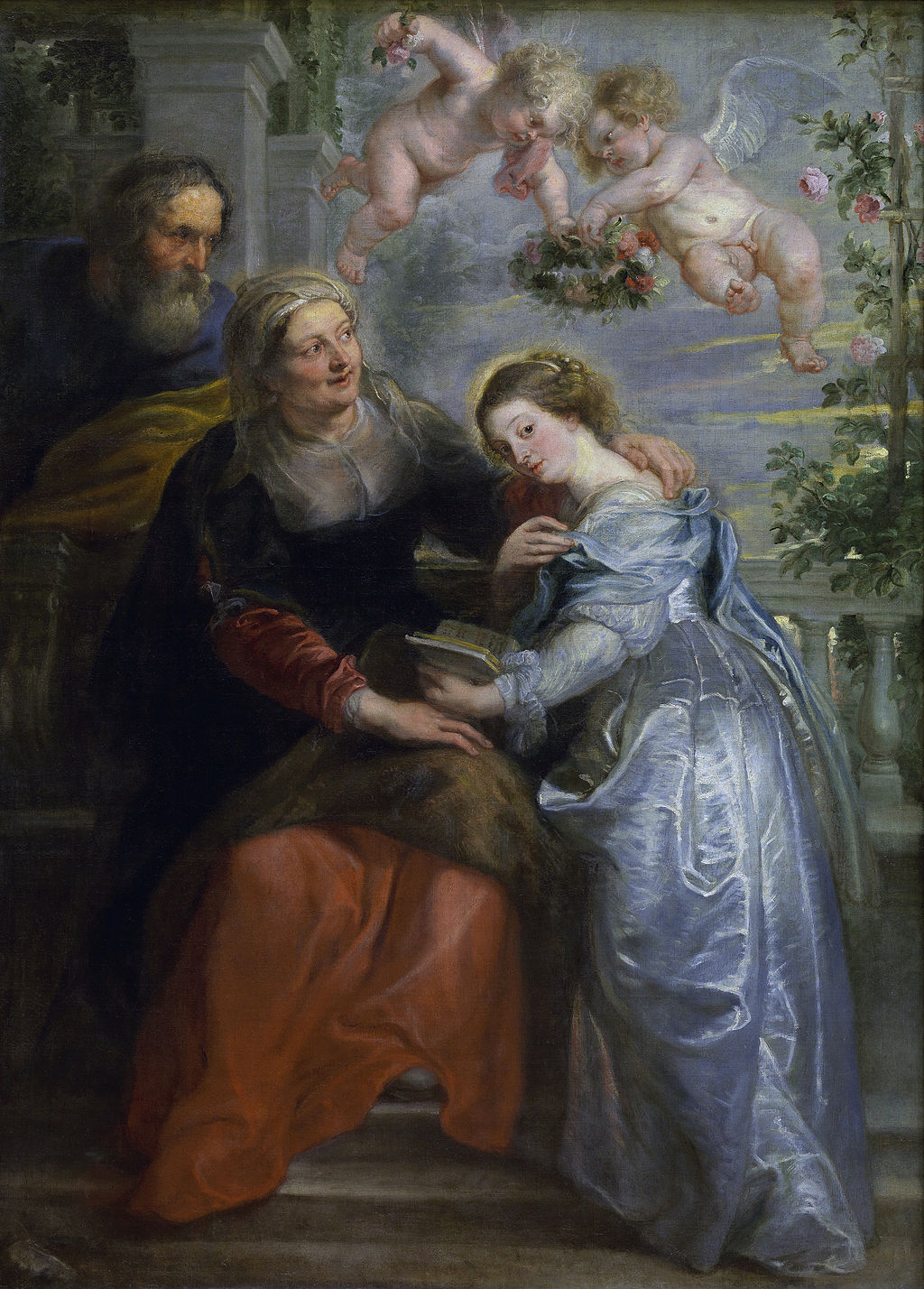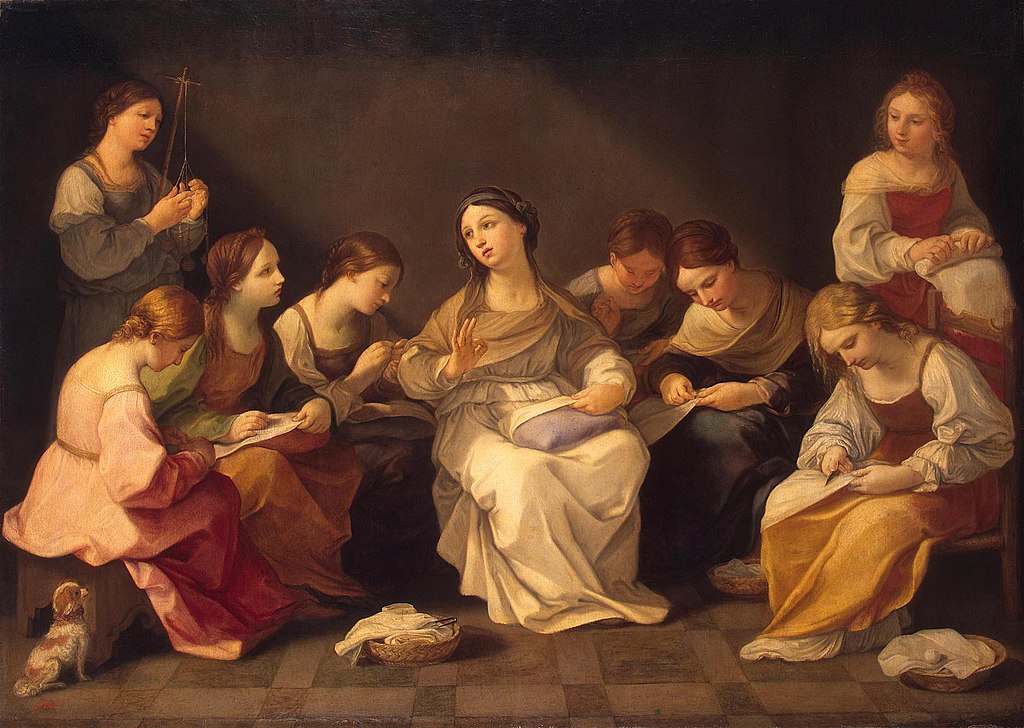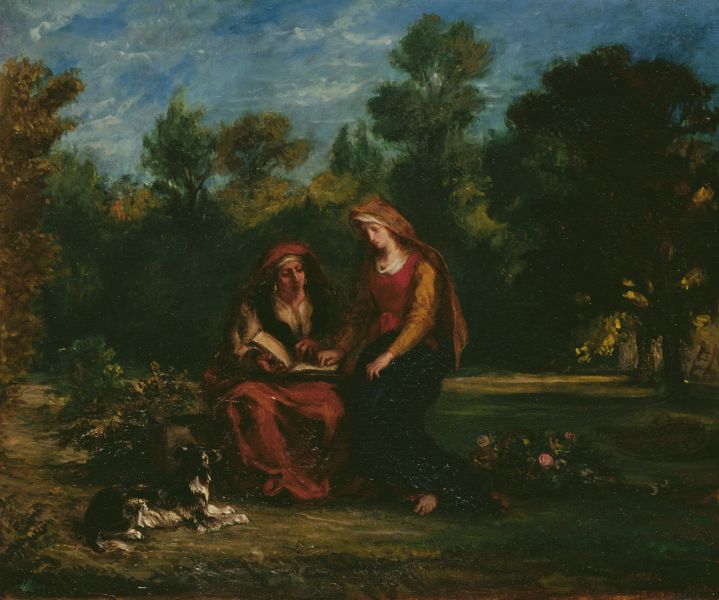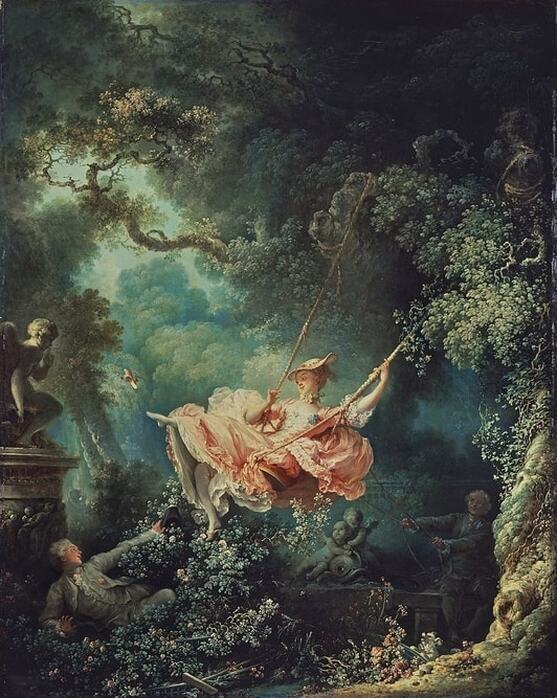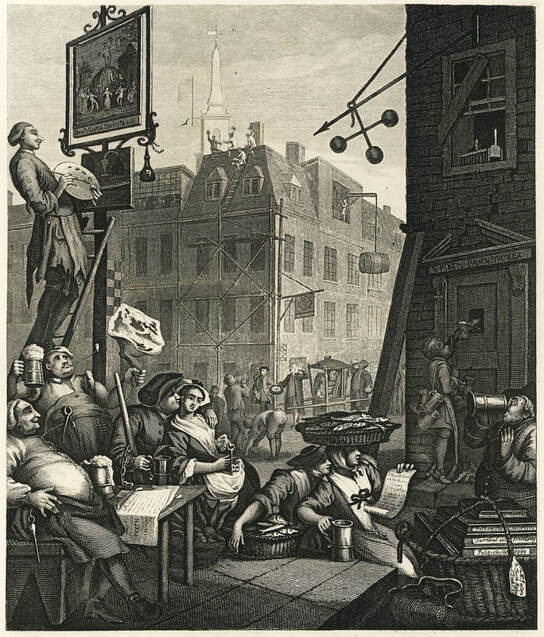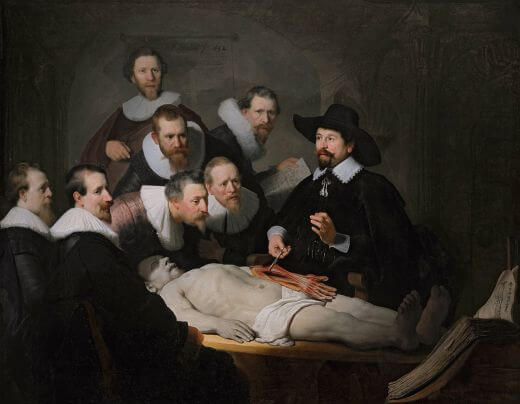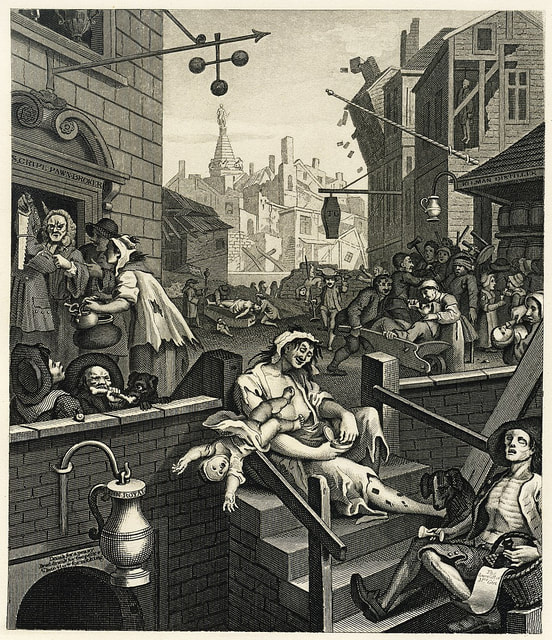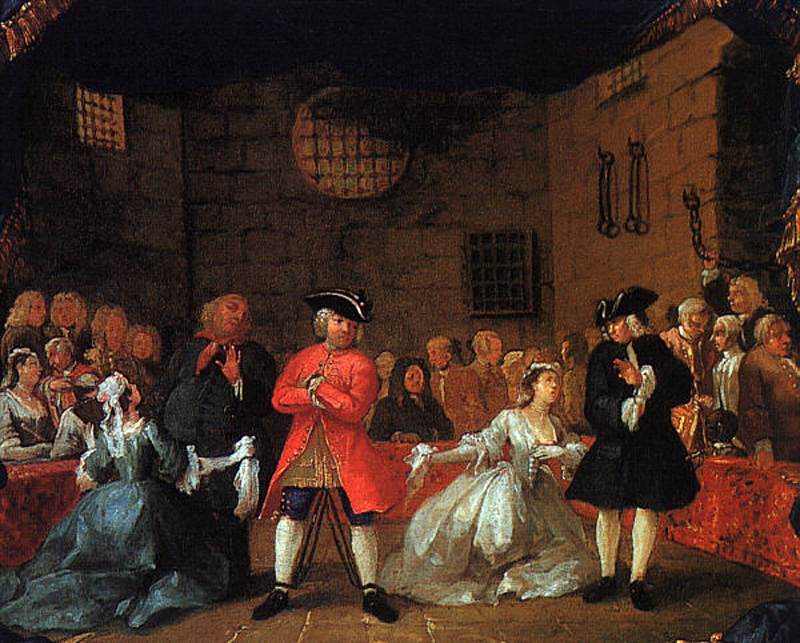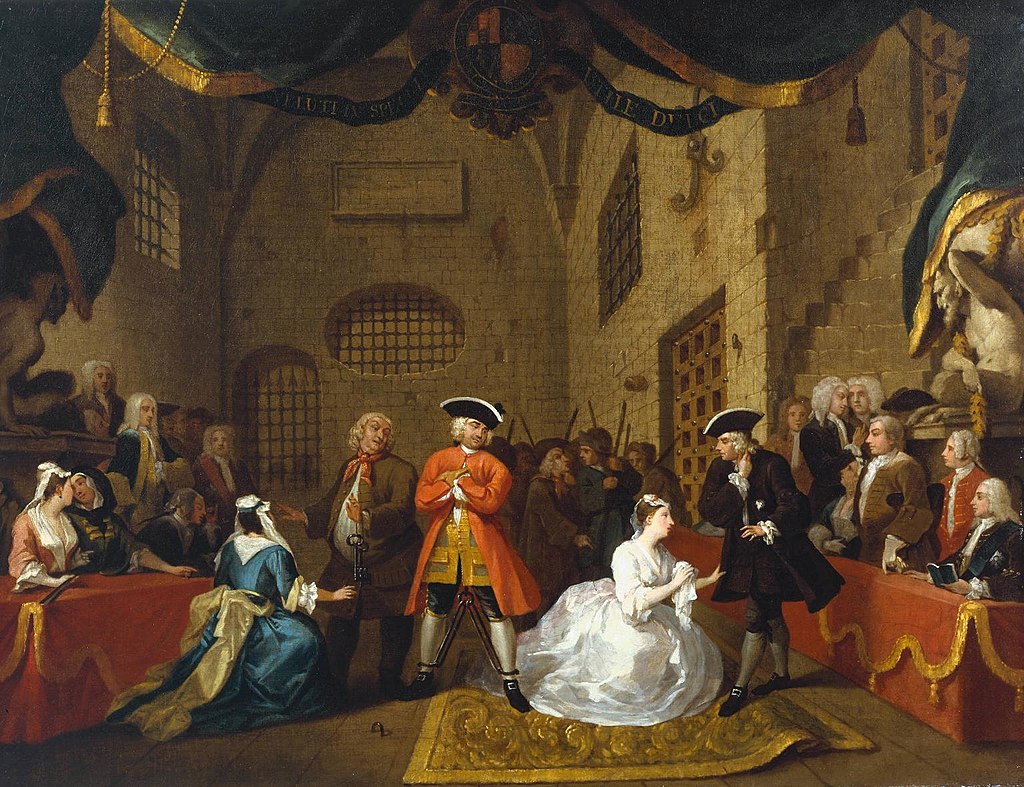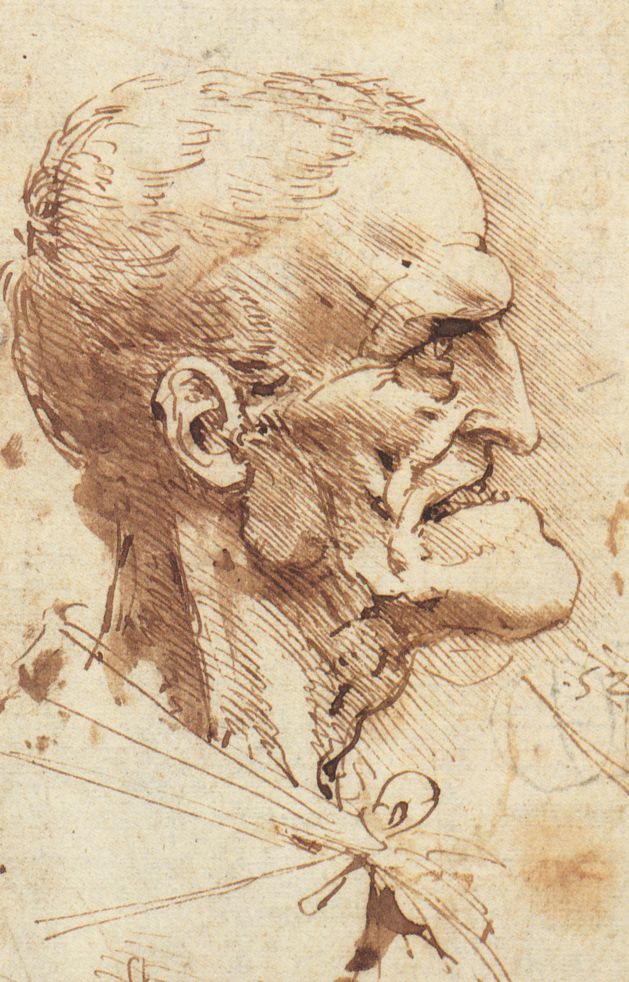|
Where? The Oval Drawing Room of the Wallace Collection
When? 1767-1768 What do you see? Golden light pours through the trees of a garden. A young woman in a brilliant pink dress sits on a large swing that is attached to the trees behind her. She kicks off one of her pink shoes (look above her raised foot) in the direction of the statue of a cupid on the left. As her skirt flares upwards, her young lover in the lower left is taken aback by the sight before him. He has his hat in his left hand. Unaware of the scene in front of him, an older man smiles as he operates the swing in the lower right. Near his feet is a little white dog that perhaps symbolizes an ironic fidelity. The sculpture of the cupid on the left was created by Étienne-Maurice Falconet in 1757 and versions of this statue are in the British Museum, Louvre, and the Rijksmuseum. It is popularly known as Menacing Love, and shows cupid looking down on the scene while putting a finger to his lips saying: “this is a secret.”
Backstory: This painting is also known under the more complete title “The Happy Accidents of the Swing.” This title refers to the erotic references in this painting. The man that is hiding in the bushes on the left has a chance to look at the woman’s legs under her skirt. The slipper that the woman kicks in the air and the hat of the man are a reference to their sexual availability. The statues of the cupids confirm the sexual intentions of the couple even more.
Fragonard’s painting soon gained recognition, and he became popular with a small group of patrons with a taste for erotic works as well as history painting. As such, The Swing played an important role in boosting Fragonard’s artistic career. Who is Fragonard? Born in 1732, Jean-Honoré Fragonard was a French Rococo painter. As a boy, he had a passion for drawing and eventually became the student of François Boucher. In 1752, Boucher suggested Fragonard to apply to study under Carle Van Loo, the court painter to Louis XV. This involved studying at the French Academy in Rome. While there, Fragonard made many sketches of the countryside and copied many Baroque-style paintings by Hubert Robert. His good work in the Academy was admired by many, and even Louis XV purchased one of his artworks. Fragonard soon gained more recognition and earned a studio in the Louvre Palace as well as the title of an Academician. Over time, Fragonard painted in many styles: Baroque, Romantic, and Rococo. In addition, he painted a variety of paintings, including landscapes, portraits, party scenes, and religious paintings. As his frivolous Rococo paintings were not also easy to sell, he also created some more traditional works on commission, such as the Education of the Virgin in the Legion of Honor Museum.
What is Rococo? An art style popular between 1720 and 1780 in Europe. The style is relatively chaotic and theatrics, leading to artworks that are full of drama, emotion, and movement. The style is highly feminized and popularly used in the French salons run by women in the 18th century. Some of the most successful artists following this style include François Boucher, Jean-Honoré Fragonard, and Antoine Watteau.
Fun Fact: Fragonard was not the artist originally commissioned to paint the swing. At first, Gabriel-François Doyen was given the task by an anonymous man of the court. He had requested a painting of his mistress being pushed on a swing by a bishop as he admired her from below. However, Doyen turned him down. Instead, Fragonard took up the task. Fragonard did not follow all the instructions of the commissioner and kept his own artistic freedom. For example, he decided against painting the man pushing the swing as a bishop. And he included some extra details to the painting such as the little dog, statues of cupids, and the lost slipper.
0 Comments
 Original version of Self Portrait in a Straw Hat (1782) Original version of Self Portrait in a Straw Hat (1782)
Where? Room 33 of the National Gallery in London
When? 1782 Medium and size: Oil on canvas, 97.8 × 70.5 cm. What do you see? A self-portrait of the 27-year old Élisabeth Vigée Le Brun. She painted herself standing outside, wearing a straw hat with an ostrich feather and a garland of wildflowers. And she holds a palette and seven brushes in her left hand. She portrayed herself as an independent and emancipated woman, traits that helped her to become a successful artist in a male-dominated art world. Many other young ladies would have worn a corset, a wig, and a lot of make-up. Instead, Vigée Le Brun portrays herself in a fashionable, pink cotton dress, a black shawl, a straw hat, a pair of earrings, and her own hair. Vigée Le Brun paid particularly careful attention to the impact of two light sources, the sunlight and the daylight. The impact of the sunlight is apparent when looking at how she painted her eyes in the shadow of the straw hat. The result is that the viewer is naturally directed to look at her neck and chest. Backstory: The painting in the National Gallery is actually a copy of a version she made earlier in 1782 and exhibited at the Paris Salon. The original painting is in a Swiss private collection and only a low-resolution image of it is available. The self-portrait of Élisabeth Vigée Le Brun was inspired by the Portrait of Susanna Lunden (c. 1622-1625) by Peter Paul Rubens, which is also part of the collection of the National Gallery. In 1782, during her travels with her husband, she came across Rubens’ portrait in Antwerp. She was particularly impressed by the way Rubens simultaneously incorporated the effects of both natural daylight and sunlight. She immediately started to apply these ideas to her own portrait. After she returned to Paris, she created a second version of this painting, which is the one in the National Gallery today. The same year she also painted the Portrait of Yolande-Martine-Gabrielle de Polastron, Duchess of Polignac, which has a quite similar composition.
Where? The French Gallery of the Timken Museum of Art
When? 1758 What do you see? Two lovers rest by a trail in a blooming garden. Their clothes are disheveled and unbuttoned. With one hand, the young man puts flowers into his lover’s hair. In the other hand, he holds her hat, filled with pastel-colored blooms. Resting her arm on his knee, the young lady holds a wreath of blue flowers on her arm. As she looks off to her right, she doesn’t seem to notice the shepherdess entering on the left side of the painting. This woman wears less lavish clothes than the couple, and she carries two baskets of flowers. She tilts her head as the young man flirts with her in an act of playful infidelity. And the young man’s lover doesn’t seem to mind. On the bottom right is a spaniel, which either is the dog of the couple or an ironic symbol of loyalty. Above the scene is a statue of two babies playing and watching the scene unfold. Backstory: Boucher probably created this painting to decorate the salon of an aristocrat’s country house. Focusing on the theme of love, Boucher sets the intimate and dreamy scene in a beautiful garden. Like most Rococo paintings, the colors and textures of the painting are delicate, soft, and feminine. Besides romance and coquetry, this painting also shows a romanticization of the peasantry in France during this time. Many aristocrats of this time fantasized about life in the country, working as a farmer or milkmaid. The inclusion of the young shepherdess in this painting may be a nod to this trend. While very beautiful, rococo paintings like Lovers in a Park, were often criticized for their artificiality and unrealistic subject matter. Who is François Boucher? François Boucher was born in Paris in 1703 where he would die in 1770. His father was a decorator who specialized in embroidery. Boucher studied under François Lemoyne and later under François Cars, an esteemed engraver. During this time, Boucher engraved many of Watteau’s drawings and became familiar with his style very quickly. In 1723, Boucher was awarded first place in the Academy competition. Afterwards, he traveled to Italy where he studied with Carle Vanloo. Though his style was not heavily influenced by this trip, when he returned to Paris, he became fascinated with fashion and sought to depict it in his works. After being admitted to the French Academy in 1734 for his work, Rinaldo and Armida, Boucher caught the attention of Madame Pompadour who essentially made him her personal painter. It was around this time that Boucher took a young Jean-Honoré Fragonard on as a student. In 1755, Boucher began working on tapestries for the Gobelins tapestry works, producing pieces for operas and festivals. In 1765, he became the director of the French Academy and Madame Pompadour appointed him First Painter to the King.
Fun fact: A leisure activity for many aristocrats of this time was to dress up in simpler clothes made out of cheaper materials and role play the idealized life of a peasant. The clothes they wore, though plainer than their usual outfits, would be higher quality than what peasants actually wore. The young shepherdess in Lovers in a Park wears clothing in this style.
Where? Room 64 of the Prado Museum
When? 1814 Commissioned by: The Spanish government What do you see? A group of French soldiers on the right point their rifles at a Spanish peasant dressed in white. The French firing squad is about to execute the peasant who stands against a hill with his arms raised like a Christ figure in surrender. At his feet are some of his comrades who have been slaughtered by the firing squad, their blood still running on the dirt. And surrounding them are other people that are next in line to face the firing squad. Some of them cover their eyes as they do not want to witness the gruel scene in front of them. Among the people surrounding the man in white is also a bold-headed monk. He is directly to the left (from our point of view) of the man in the center, and he has his hands clasped in prayer, avoiding the eyes of the soldiers. Backstory: This painting is a commemoration of a true historical event, Napoleon’s French army invading Spain. This painting shows a particular scene that occurred on May 3, 1808, when the French army decided to execute Spanish citizens that rebelled against them. Francisco Goya was deeply affected by this series of events and decided to create this painting to show the injustice of the French army’s actions. Goya has dramatized the moment. The square lantern in the center pours bright light onto the rebels on the left and the man dressed in white. Goya gives him a Christ-like aura with his arms raised in golden light. The man is made into a martyr while the French soldiers are left anonymous and thus soulless. May 2, 1808: This was the day that many citizens of Madrid rebelled against the French occupation. Crowds assembled around the Royal Palace of Madrid protesting French occupation. The French soldiers opened fire on the crowds, triggering street fights and rebellion in other parts of the city. The French armed forces outnumbered the Spanish citizens. Goya captured the events on this day in his painting The Second of May 1808, which is also in the Prado Museum. The painting depicts the Mamelukes (Napoleon’s Turkish soldiers) in a street fight with Spanish rebels. When the conflict had subsided, hundreds of Spanish citizens had died. Many survivors were taken prisoner for execution the next day.
May 3, 1808: The day after the Spanish rebelled against the French army, the rebels were executed by French firing squads. Many surviving Spanish rebels were gathered and shot in several locations in Madrid. Supposedly, most of the executed rebels were peasants, artisans, and beggars. About one hundred deaths by firing squads were reported.
Who is Goya? Francisco Goya was born in 1746 in Fuendetodos in the Northeast of Spain and died in 1828 in Bordeaux, France. He studied drawing and painting in Zaragoza and joined the studio of José Luzán. Later, he studied under Francisco Bayeu Subías who led him to work on decorations for the royal palace. Goya married Subías’s sister and traveled to Italy after failing in two drawing competitions at the Real Academia des Bellas Artes in San Fernando. Eventually, Goya was appointed painter to the Royal Tapestry Factory in Madrid. Goya's work was reminiscent of Rococo art and focused on day-to-day events. As his work gained more attention, Goya rose to the position of court painter to King Charles III and Charles IV. Around this time, he began to travel Andalusia to study realism. When he returned from his trip, he had fallen ill and gone deaf. Before the decline of his health, much of Goya’s work had been cheerful and warm. After losing his hearing, Goya’s work became dark and filled with monsters, darkness, and ghosts. Witches’ Sabbath in the Prado Museum is an example of such a dark work. It is part of his series of fourteen Black Paintings.
Fun fact: Before painting The Third of May 1808, Goya had worked on a series called The Disasters of War. These gruesome prints showed the violence, gore, and fear that comes from war. Without taking a side in the conflict, Goya expressed great anti-war sentiment. The prints were not published until decades later.
Where? Gallery 7 of the Legion of Honor Museum
When? About 1773 What do you see? A young Mary comfortably leans back against her mother, Saint Anne, who teaches the Virgin Mary about the Bible. Mary has her finger on the Bible questioning her mother about a certain aspect. However, Mary seems confident as well and enjoys this activity with her mother. Fragonard included strong contrasts between mother and daughter. Mary is tiny and has a pale, doll-like face. Her oversized mother looks like a wise and experienced woman. On the left, they are accompanied by two small angels hovering next to the Bible to give them divine inspiration. On the right, they are joined by a white cat. Fragonard paints a mysterious light source in the background giving this painting a magical feel. The bottom left of the painting probably has been damaged over time, but, interestingly, the vaguely applied pink and brown paints add to the magical feeling of this work. Background: Fragonard got the inspiration for this painting from earlier works on this theme by Peter Paul Rubens and Giovanni Battista Tiepolo. Rubens painted the theme between 1630 and 1635 and this work is on display in The Royal Museums of Fine Arts in Antwerp. Between 1730 and 1732, Tiepolo painted the theme multiple times, including a version in the Santa Maria della Fava Church in Venice. Fragonard first copied the works of these artists but then created his own, unique composition of this theme. However, when he finished the work, it was not received well by the art critics of that time. It inspired him to create some other versions of this work.
The youth of Mary: The youth of the Virgin Mary is described in the apocryphal Gospel of James. Mary is the daughter of Saints Anne and Joachim. They were wealthy people, but Anne was infertile. After a desperate prayer to God, an angel appeared to her promising a child that would become famous. Anne became pregnant without intercourse with her husband.
When Mary was three years old, her parents brought her to the Temple where she would be raised by the priests and received food from the hand of an angel. When she was 12 years old, God picked Joseph, a widower with older children, to be Mary’s guardian and to become her husband when she was old enough. And when Mary was 16 years old, she became pregnant without having intercourse. Joseph actually only discovered her pregnancy when he came back from a house-building trip when she was already six months pregnant. The Education of the Virgin: The story of Saint Anne teaching her daughter Mary about the Bible only developed in the 11th century AD. It is not mentioned in the Gospel of James, which is the main source of information about Mary’s youth. In contrast, the Gospel of James mentions that Mary lived with the priests at the Temple between her third and twelfth year. The only skill of Mary mentioned in the gospel is that she was good at weaving. But 11th-century logic told priests and scholars that, as the Mother of Jesus, Mary also had to be able to read and be knowledgeable about the Bible. And so, artists in the next centuries started to depict Saint Anne teaching Mary about the Bible. Multiple versions: Fragonard created multiple versions of The Education of the Virgin. The version in the Legion of Honor Museum was probably the first version and painted around 1773. After that, he made two drawings of the painting for which he used the same composition but experimented with different lighting effects. During the second half of the 1770s, Fragonard created a second series on this topic. In these later paintings, Mary is no longer looking at the Bible but at her mother instead. The education of the virgin was a theme that multiple artists have used over time. Besides Rubens and Tiepolo, Guido Reni painted between 1640 and 1642 a version in the Hermitage Museum. And between 1842 and 1852, Eugene Delacroix also painted a couple of versions of this theme, one in The National Museum of Western Art in Tokyo, and another one is owned by the Louvre.
Who is Fragonard? Jean-Honoré Fragonard was born in 1732 in Grasse in the Southeast of France and died in 1806 in Paris. He started his career as a fairly traditional artist, but during a trip to Italy in his late twenties, he started to become interested in more theatrical works. He got inspired by the works of artists like Hals, Rembrandt, Rubens, and Tiepolo, and decided to create colorful, chaotic paintings about love and happiness.Among these paintings is his best-known work, The Swing in the Wallace Collection in London.
However, his new style of painting was not well-received by everybody, and he still continued to paint some more traditional religious works on commission. After the French Revolution in 1789, Fragonard continued to paint, but his name was forgotten quickly.
Fun fact: The theme of the education of the virgin has contributed significantly to the development of female literacy. Whereas in the early Middle Ages only men were depicted holding a book, the increasing popularity of Saint Anne teaching Mary how to read the Bible was a sign to people that it was also important for women to learn how to read.
Images of Mary being able to read the Bible did not remain restricted to Saint Anne teaching her. The Annunciation by Leonardo da Vinci in the Uffizi Museum shows that Mary is reading the Bible when the Archangel Gabriel announces to her that she will be the Mother of Jesus.
Where? Room 1730 of the Main Floor of Tate Britain. Several other museums like the British Museum, Metropolitan Museum of Art, and National Gallery of Art also own this work but do not have it on permanent display.
When? 1751 What do you see? Several groups of well-fed people engage in a variety of activities while drinking mugs of beer. It is the birthday of King George II, and that asks for a celebration. On the left, two corpulent men hold big mugs of beer and one of them holds a huge leg of beef in his left hand. In front of them sits a man holding a beer while sharing a romantic moment with a woman. To the right of them, a couple of women with overflowing baskets of fish pause while enjoying a beer. To their right, a young boy with mugs hanging on a rope slung over his back goes around selling mugs of beer. He stops at the pawnbroker to hand him a beer through the peek hole. The pawn shop is in some state of disrepair as people do not need to pawn off their belonging in this prosperous world where people drink beer. The other buildings are well-maintained, and the church steeple on the top is a sign that people behave morally in this world full of beer. On the bottom right, a portly man enjoys his beer next to a pile of books in a basket. On the left, a painter in ragged clothes blissfully paints a cheery picture of men and women dancing around a mountain of barley. On top of the roofs, construction workers take a break drinking to celebrate while another barrel of beer is being lifted up. Finally, in the center, a wealthy woman in a sedan chair waits as her chairmen have temporarily put her chair down to drink a beer. Laborers around them drink their beer while continuing their work in a timely manner. Backstory: Beer Street takes place during a major movement in 18th-century England: The Age of Enlightenment. This was a philosophical and intellectual movement where people began to ponder major scientific and philosophical thoughts that were captured in paintings such as The Anatomy Lesson of Dr. Nicolaes Tulp by Rembrandt. These ideas were published, and many people learned from them and developed them further. Another idea behind the Age of Enlightenment is that people were trying to apply these new ideas to help other people. Before the Gin Craze, French brandy was popular and fashionable, however, during the Second Hundred Years’ War between France and England, French products were considered unpatriotic and soon lost their following. This led to the Gin Craze where gin and other cheap spirits quickly became popular, and overconsumption of these drinks caused many problems among the lower-class people. William Hogarth’s print was, in essence, a piece of propaganda in favor of the British beer market. Similar to the popularity of Coca-Cola in the United States during modern times, Hogarth makes the argument that beer was not only a remedy to the unregulated gin trade but also a drink that is truly British and helps the country.
Gin Lane: At the time Hogarth created Beer Street, he also created a companion piece called Gin Lane. Most museums that own Beer Street, also have a print from Gin Lane as they were created together. Museums owning Gin Lane include Tate Britain, the British Museum and the National Gallery of Art. However, most museums do not have the prints on permanent display as they are light sensitive. The original copperplates for both works are owned by the Metropolitan Museum of Art.
Gin Lane shows the perilous effects that excessive gin consumption can have on your life. It shows the opposite side of Beer Street where drinking gin leads to chaos, negligence, street brawls, and poverty. The only ones benefiting from the gin craze are the distillery, the pawn shop, and the undertaker.
Who is Hogarth? William Hogarth was born in 1697 in London where he would die 66 years later. Hogarth carefully examined life in 18th-century London and detailed it in etchings and painted satires. He included many symbolic features in his works such that his pieces are not only entertaining but also contain several moral messages.
Hogarth created art both for the upper and lower class. He painted works for his richer clients but also created etchings and engravings of his works that could be mass-produced and sold at a lower price to a larger audience. Among his works is a series of satirical works about the British upper class. The first painting of that series is Marriage A-la-Mode: 1, The Marriage Settlement in the National Gallery in London.
Where? Room 1730 of the Main Floor of Tate Britain. Several other museums like the British Museum, Metropolitan Museum of Art, and National Gallery of Art also own this work but do not have it on permanent display.
When? 1751 What do you see? People in various states of physical and mental decline amid a chaotic urban setting. In the center sits a woman with ragged clothes. Her shirt is open exposing her breasts, and she has sores on her legs. She neglects her baby who falls out of her arms and does not even notice what is happening. Just down the steps from her lies a malnourished soldier who looks like a skeleton. He has his head tilted back and holds on to an empty glass of gin. A dog with a saddened expression looks over him. The soldier has a basket tucked under the crook of his arm with a bottle and note that reads “The Downfall of Gin.” To the left of the central woman, two men fight with a dog over a bone signifying how far they have fallen because of their gin addiction. Standing above them, a couple of men try to pawn off possessions to buy more gin. On the right side, more people lose themselves to the cheap spirits. People are feeding gin to each other, including children, and even a baby. In front of the distillery on the right middle, a fight breaks out and people hit each other with chairs and hammers. There is a strong contrast between the different buildings in this town. Most buildings in the background are in poor condition, except the distillery, the pawn shop, and the undertaker’s building. Backstory: Gin Lane is an etching and engraving printed on paper. Hogarth chose this technique to be able to produce multiple prints of his work that he could sell for low prices to lower-class people. Gin Lane showcases the vicious cycle of excessive drinking, pawning off your possessions to drink more, prostitution, and finally death. Gin drinking was considered a large problem in England during the time that Hogarth created this work. It was cheap and accessible to the working class, and many people got addicted to gin with all the bad consequences that result from that. Gin Craze: In the beginning of the 18th century, gin was not regulated in England, and distillers did not care much about the drink’s quality. They mixed in harmful chemicals and did anything to increase their margins. The drink became very popular among the lower class in England, and especially in London. Many people consumed large quantities of gin, which made them even poorer and led to health problems. The problems with gin led the government to take several measures between 1729 and 1751 to make gin more expensive and reduce its popularity. These measures only had a partial effect, and it was not until the 1750s that the gin consumption decreased mainly due to a series of poor grain harvests. Beer Street: At the time Hogarth created Gin Lane, he also created a companion piece called Beer Street. Prints of this work are part of multiple collections, including the British Museum and the National Gallery of Art. The original copperplates for both works are owned by the Metropolitan Museum of Art. Beer Street presents an alternative to the ails of gin drinking. It shows the opposite of the street where we see that beer drinking leads to prosperity. It shows a town that is flourishing with healthy individuals engaging in fun activities. For example, the pawnbroker that thrived in the chaos in Gin Lane is in disrepair as no one wants to pawn items to support their habit.
Who is Hogarth? William Hogarth was born in 1697 in London where he would die 66 years later. He enjoyed creating art which explains the social ills of 18th-century England through a combination of wit and symbols that would be easy to understand for his 18th-century audience. He created art both for the upper and lower class.
Hogarth painted works for his richer clients but also created etchings and engravings of his works that could be mass-produced and sold at a lower price to a larger audience. An example of a work for the upper class is A Scene from 'The Beggar's Opera' in the National Gallery of Art. Another version of this painting is in the same room as Gin Lane in Tate Britain.
Fun Fact: In addition to being a political satirist, William Hogarth is known for his caricatures of people. Look, for example, at the man hanging from the rafters in the top right of Gin Lane or the man in the center walking down the street with a baby on a stake.
Other artists like Leonardo da Vinci and Eugene Delacroix also liked to create caricatures of people. One of Da Vinci’s many caricatures is a drawing of a Grotesque Profile. An example of a caricature by Delacroix is A Lioness and a Caricature of Ingres in the Metropolitan Museum of Art. |
Categories
All
|
- Home
- Blog
-
Museums
- Alte Pinakothek
- Art Institute of Chicago
- Baltimore Museum of Art
- Barber Institute of Fine Arts
- Bargello
- Barnes Foundation
- British Museum
- Church of Sant’Anastasia
- Cleveland Museum of Art
- Courtauld Institute of Art
- Detroit Institute of Arts
- Frans Hals Museum
- Galleria Borghese
- Gallerie dell'Accademia
- Getty Museum
- Guggenheim
- Hermitage Museum
- Kunsthistorisches Museum
- Kunstmuseum Basel
- Legion of Honor Museum
- Louvre
- Mauritshuis
- Metropolitan Museum of Art
- Musee d’Orsay
- Museum of Fine Arts in Boston
- Museum of Modern Art
- National Gallery in London
- National Gallery of Art
- National Museum in Poznań
- Norton Simon Museum
- Ny Carlsberg Glyptotek
- Palace of Versailles
- Palazzo Pitti
- Palazzo Vecchio
- Petit Palais
- Philadelphia Museum of Art
- Prado
- Pushkin Museum
- Ravenna Art Museum
- Rijksmuseum
- San Diego Museum of Art
- Santa Maria delle Grazie
- St. Peter's Basilica
- Städel Museum
- Statens Museum for Kunst
- Tate Britain
- Tate Modern
- Timken Museum of Art
- Uffizi
- Vatican Museums
- Wallace Collection
-
Artists
- Altdorfer
- Anguissola
- Berlin Painter
- Bosch
- Botticelli
- Boucher
- Bronzino
- Bruegel the Elder
- Brunelleschi
- Cabanel
- Caillebotte
- Canova
- Caravaggio
- Carpeaux
- Cezanne
- Cimabue
- David
- Degas
- Delacroix
- De Maria
- Donatello
- El Greco
- Fontana
- Fra Angelico
- Fragonard
- Gauguin
- Gentileschi
- Gericault
- Gonzalez-Torres
- Goya
- Hals
- Hogarth
- Hokusai
- Ingres
- Leonardo da Vinci
- Lippi, Filippo
- Longhi, Barbara
- Lorrain
- Makovsky
- Manet
- Massys
- Matisse
- Merian
- Michelangelo
- Mochi
- Modigliani
- Monet
- Panini
- Parmigianino
- Perugino
- Picasso
- Pisanello
- Raphael
- Rembrandt
- Renoir
- Reynolds
- Rivera
- Rodin
- Rubens
- Scultori
- Seurat
- Steen
- Tintoretto
- Titian
- Toulouse-Lautrec
- Turner
- Uccello
- Van der Weyden
- Van Dyck
- Van Eyck
- Van Gogh
- Van Hemessen
- Vasari
- Velazquez
- Vermeer
- Veronese
- Vigée Le Brun
-
Locations
- Books
- About Us


